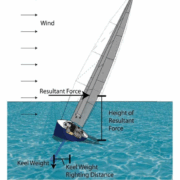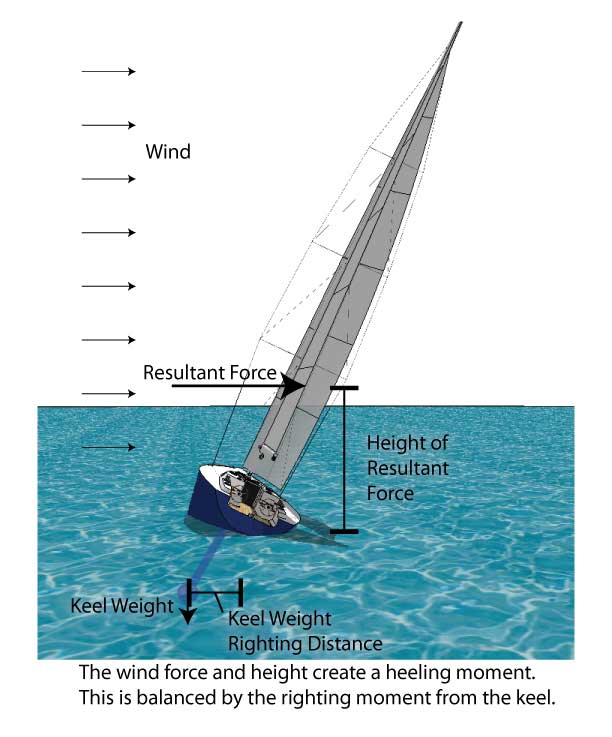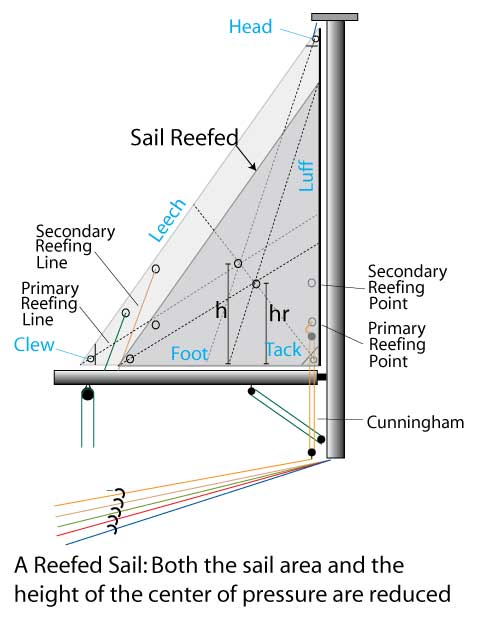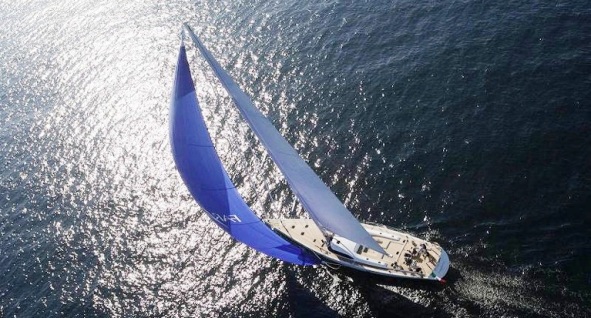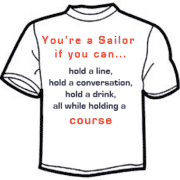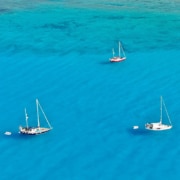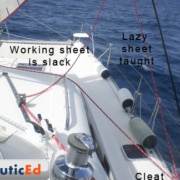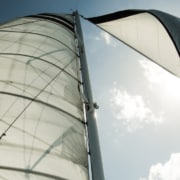When to reef a sailboat
While all sailboat designs are different and will sail optimally at different heel angles and reef points, there are a few generalities that we’ll cover in this sailing blog.
General reefing point number 1 through infinity: Don’t scare the beegeebees out of those on board by heeling the boat over too much. While you may be singing and enjoying yourself, others may be frozen solid.
One time sailing off Corsica (lovely sailing destination btw) we encountered a 40 knot Mistral breeze. We were sailing a Beneteau 50 and what a delight it was. The waves were about 8 feet and consistently washing over the deck. It was a beautiful day and we all had a blast – EXCEPT one person on board who had not been sailing much before. When we reached the marina in Bonifacio he jumped off the sailboat and lay flat on the dock kissing the dock boards. I learned that he had been so terrified that he could not speak and was looking between each wave where to jump clear of the boat it in case we went over. Lesson learned for me! That’s not a good thing to do to your guests and not a good way to keep the sport of sailing growing.
Funny as it is (sort of), now I make sure that everyone new on the boat knows to look first into my face when they start to get scared. I tell them that if I’m smiling then it’s all ok and that they are only allowed to get scarred if they see worry and fear on my face. Now the thing to do is to not show fear through facial expressions or through my voice. This keeps the crew thinking straight and following instructions instead of worrying about jumping clear of the boat.
Ok back on topic to heel angle and reefing. We’ll cover non-spinnaker/genaker operations here because broaching (getting knocked down) with those sails is a different topic.
Certainly in light winds, some heel angle will ensure your sails have some airfoil shape to them so position your crew to leeward to create at least about 5 degrees of heel angle. As the winds pick up you can begin to move your self moving ballast (crew) to the windward side to balance the wind force aloft in the sails.
In general, for most cruising sailboats, once you reach about 25 degrees or so the sailboat hull design and sail rig design will begin to reduce the ability of the boat to increase in speed in an efficient manner. OK wow that’s a very general statement but it’s a statement that will allow you to watch, learn and experiment with your own particular boat.
A weighed keelboat typically is not in danger of capsizing for three main reasons:
- As the boat heels over the distance aloft to the center of pressure of the wind is lowered and thus the heeling moment is reduced. As an example, lets say the boat leaned all the way over. This heeling moment then is reduced to zero. So theoretically the wind can’t heel you all the way over anyway.
- As the boat heels over the vertical area of the sails presented to the wind is reduced which reduces the actual heeling force.
- As the boat heels over the weighted keel is lifted to windward thus creating a righting moment. The more the keel is lifted to windward the more the righting moment.
From above then, the more the boat heels over, the less the “heeling” moment from the sails and the more the “righting” moment from the keel. Or again in very not tech speak: in a full laydown situation there is no more tipping over force left and only straightening up force remaining. It might not feel like that when your hanging onto the rails for dear life but it’s pretty much the reality of the nature of forces and moments.
What is “moment”? Moment is the ability to use a screw driver to open a paint can. Imagine a very stubborn paint can and a very short screw driver. Now use a longer screw driver you can imagine the force needed becomes much less. That’s moment. It’s not the force that opens the can but the moment. Moment is mathematically force x distance. In the same manner it’s not the force that heels the sailboat over it’s the height of the wind times the force of the wind.
Mathematically, when you apply wind pressure to a triangle (sail) the center of force can be equated to be at the position of 1/3rd of the way up the triangle/sail.
Here’s a few more equations. Lets assume a right angle triangle.
- Force = pressure x sail area presented vertically to the wind = pressure x foot length x sail height x (cosine (heel angle))/2
- Pressure = ½ (density of air) x (wind velocity)Squared
- Height of force above the sail foot = 1/3 rig height * cosine (heel angle)
- Moment = force x height
Or to wrap it up into easy terms:
Moment is proportional to the following:
- wind velocity squared
- the cosine of the heel angle squared
- the rig height
- the foot length.
In practical terms if the heel angle is 30 degrees the heeling moment is reduced to 75% or if the heel angle is 90 degrees (laying down flat) the heeling moment is zero zip nada.
Also note that in the above, if you go from 5 knots to 20 knots the heeling moment goes up 16 times. In most sailboats you should be looking at reefing anywhere from 12-15 knots. The other thought process to use is when you are starting to think about reefing, you probably should have reefed ½ an hour ago.
What effectively is reefing the sails doing? Well, it’s just reducing the sail area and the height of the position that the wind force acts upon the sails. As an example if the sail was reefed down 15% of its height the area is reduced by 0.85 squared = to 72% of it’s original but the heeling moment is reduced even further because the center of pressure on the sail is lowered . IE reefing has a cubic effect on reducing the heeling moment. Wow that’s pretty enlightening.
Another consideration regarding reefing and heeling is that the more you heel over the less effective is the rudder because you’ve reduced the vertical presentation of the rudder to the horizontally flowing water. IE at a 45 degree heel, you’ve lost 30% of your rudder area which gives you less ability to handle the weather helm from a gust. This can put you into a dangerous rounding up position. And believe me rounding up can be VERY dangerous. One time when sailing along I saw two things about to happen – a gust was on its way across the water towards us and a boat was heading towards us to pass to windward. A rounding up in this gust would drive us right into the oncoming boat. I reached over and let out the mainsheet. This twisted out the top of the sail and effectively lowered the heeling moment but keeping the bottom of the sail powered. The gust passed with out a round up. Just think what if I’d been below and a rookie was helming the boat? No, don’t think!
A sailboat Captain friend of mine who would sail regularly from the Mediterranean to the Caribbean on a 150 fter would always say, if you’re thinking about reefing, you should have yesterday. If you’re thinking about shaking out the reef, wait until tomorrow.
So when should you reef?
- So as you’re not scaring the crew
- At about 25 degrees of heel angle
- At about 12-15 knots of breeze
If you enjoyed this sailing article blog, consider taking the NauticEd Skipper and Sail Trim sailing courses. NauticEd also provides a free sailing course describing the basics of sail trim.
This article was written by Grant Headifen, Director of Education for NauticEd Online Sailing School. NauticEd provides basic to advanced multimedia online sailing courses and a globally accepted sailing certification by most all yacht charter companies.


